Gardening Secrets: How to Care for a Bromeliad Flower
A catchy tropical plant is remembered for its unusual shape and juicy color. After the first meeting, there is a desire to acquire bromeliads and learn to care for it.
Content:
- Feature of bromeliads
- How to provide ideal conditions for the flower?
- Reproduction and transplant problem
- How to stimulate a plant to bloom
- Diseases of bromeliads
Feature of bromeliads
Each plant is interesting in its own way and especially. A beautiful representative of the flora can touch the strings of the soul of even an indifferent person. In the past, travelers traveled great distances in order to obtain an exotic flower. Bromeliad was one of those coveted targets. The flower ended up in Russia, having traveled a long way from Latin America.
Representatives of the Bromeliad family - about 2500 species.
This herb is named after its discoverer, Swedish botanist Olf Bromelius. The flower has a poorly developed root of small size. The elongated leaves are fleshy. With their pointed tips, they rush upward, forming a kind of rosette.
Flowers are formed at the base of the plant. If there is a peduncle, it is very short. This inflorescence is called a head.
There is also another type of bromeliad inflorescence - panicle:
- Flowers do not grow singly, but in small groups on an axis. The lower they are, the more numerous the branching in the group.
- The fruit has three nests.
- Inside are brown oval seeds. Their size is not the same (1-5 cm), depending on the type of plant.
Flowers are the pride of bromeliads. Most species form colorful inflorescences only once: having pleased the eye, the plant dies. The positive point is that during this period a group of young shoots is formed in the place of the mother plant. The flower palette is varied: from dark to light shades. Breeders have developed varieties of yellow, purple, white and even two-colored bromeliads.
The most famous plant species:
- A pineapple
- Guzmania
- Ehmeya striped
- Vriezia
- Tillandsia
Bromeliads are divided into two classes: terrestrial and epiphytes. Representatives of the second species have adapted to life on rocks, leaves and trees... Considering them as parasites is a mistake. They do not harm their "home" in any way.
Bromelia is a large flowering plant native to the tropics that surprises with its unusual appearance.
How to provide ideal conditions for the flower?
Bromeliad is not considered a particularly capricious creature. Knowing about it will help provide proper care. When growing any plant, it is important to bring the conditions of its maintenance as close as possible to natural ones. A visitor from the tropics will love the moisture, warmth and dim but sufficient light.
Growing secrets:
- When watering a flower, you need to remember about its weak rhizome. He cannot assimilate water the way common houseplant.
- The soil in the pot is only slightly moistened, and the water is poured directly onto a rosette of leaves. This is exactly how bromeliad eats in the natural environment.
- Soft water is recommended for irrigation. The ideal option is rain. The flower will like a plentiful "shower" from a spray bottle and occasional wipes with a damp sponge.
- Top dressing also occurs through the leaves. To do this, a nutrient mixture is poured into the sprayer instead of water.
- During the period of intensive growth (summer), the flower is fertilized every 2-3 weeks. Starting in autumn, they are limited to once every several months.
- In the summer, watering bromeliads is a mandatory daily routine. There must be water in the pan. In winter, there is much less worries: it is enough to water the plant once every 7 days. Regardless of the season, the air in a bromeliad room should be humid.
- It is better to hide the flower from direct sunlight. At the same time, he will not be comfortable in poor winter lighting conditions. An ultraviolet lamp placed next to it will correct the situation. The device is pointed at the ceiling.
Bromeliad nestled under wide leaves other tropical plants, does not like drafts. When ventilating the room, care must be taken to protect it. Turning on a fan or air conditioner near the flowerpot can harm the flower.
In the warm season, the optimal temperature regime for bromeliads is 22-250C. In winter, it is enough to maintain 15-180C. If the air in the room cools down to + 120C, the flower will not survive. Adhering to simple recommendations, even an amateur gardener will provide bromeliads with comfortable growing conditions.
Reproduction and transplant problem
Growing a new plant from seeds is difficult. The first difficulty is to get the planting material from the parent specimen. Quite quickly, a sticky substance forms in the fruit, from which it is very difficult to remove the seeds.
It is much easier to buy a ready-made bag in the store.
Even in this case, it is necessary to sterilize the soil, process the seeds, and germinate them in closed glass containers. It is less problematic to take advantage of the small shoots that form in a flowering plant. In the professional world, they are called "kiki". About 3 months maternal bromeliad pleases the eye. After she dies off, leaving behind "children". They are given two months to grow up. Then they are carefully separated from the old outlet and transplanted to a new place.
In a mixture of peat and sand, the processes take root in 5-7 days. Do not be alarmed if their root system is too weak. Its main purpose is to keep young bromeliads in the ground. It is enough just to sprinkle the roots with the substrate, leaving the outlet open.
It is not worth replanting a flower without special need. Thinking about work if bromeliad is clearly grew out of a flowerpot... This can be judged by the roots peeking out of the drainage holes. Soil contaminated with salts also needs to be changed.
Transplant nuances:
- The soil is taken loose and moist.
- A container made of any material (plastic, wood, ceramics, glass) is suitable. The diameter of a round pot should be 3 cm larger than the diameter of the previous flowerpot.
- The substrate purchased in special stores is combined with sand and peat.
- Drainage is made from expanded clay.
- A small hole is made in the middle of the container, into which water is poured. In a well-moistened soil, the shoot will take root faster.
- Bromeliads are sprinkled with soil around the edges and fixed.
- It is recommended to replant the plant no more than once every few years. Considering this, it is better to choose in advance a sufficiently spacious container for a flower.
- The bromeliad that dies after flowering leaves behind shoots that are easily transplanted and rooted.
How to stimulate a plant to bloom
Seeing once amazingly beautiful flowers, I want to enjoy this spectacle as long as possible. Unfortunately, re-formation of the inflorescence is not possible. The only way to contemplate it is to accelerate the maturation of young shoots:
- Correct care - the guarantee of active growth of bromeliads "babies" and preparation for the formation of inflorescences. The plant will develop rapidly at temperatures no lower than 250C.
- To stimulate the chlorophyll production process, you need to get an Epsom salt solution. It is watered with a bromeliad rosette.
- Typically, flowers are thrown out in the summer. There is an artificial way to see them at a different time.
- Under natural conditions, ethylene accelerates the flowering process.This substance is secreted by ripening fruits.
This natural phenomenon can be used to "trick" domestic bromeliads. It is enough to cover the flowerpot with the plant with a plastic bag, placing a banana, apple or kiwi inside.
Bromeliads are not unpacked for 10 days. Then you need to be patient and wait for the flowers to appear in 6-10 weeks. There are little tricks that will make the bromeliads bloom as soon as possible.
Diseases of bromeliads
Errors in keeping conditions are immediately visible on the leaves: they either wither or become stained. To save the plant, you need to correct all the shortcomings as much as possible.
Bromeliad harm inflicted by parasites... The flower is not immune to the attack of scale insects and mealybugs.
- The first ones drink flower juice. The plant is covered with red-brown spots. After some time, these parts die off.
- Also, scabies are a source of juice that provokes the appearance of a fungus. Since bromeliad feeds on leaves, this is a tragedy for her.
- Parasites are collected by hand. After that, the outlet is washed using soap. Spray with a tobacco solution. Insecticides can be applied.
- Mealybugs are also filmed on their own. The flower is treated with a solution of green soap.
Timely help is the key to the health of bromeliads.
Bromelia is a touch of exoticism in the interior. The tropical guest fell in love with gardeners for the combination of unpretentiousness and beauty.
More information can be found in the video.




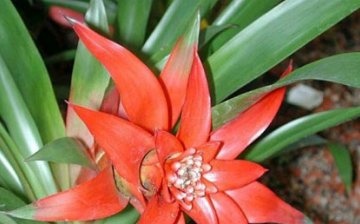

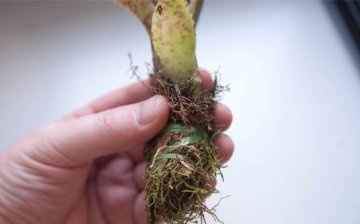
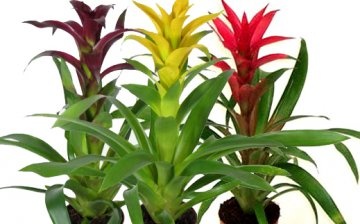







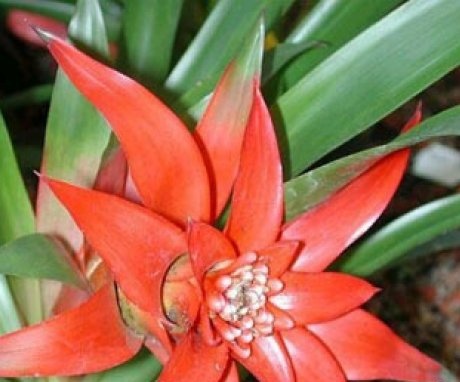
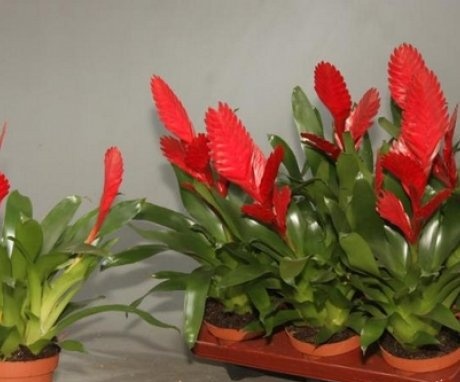
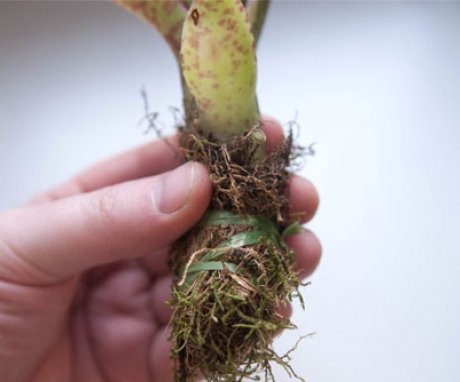
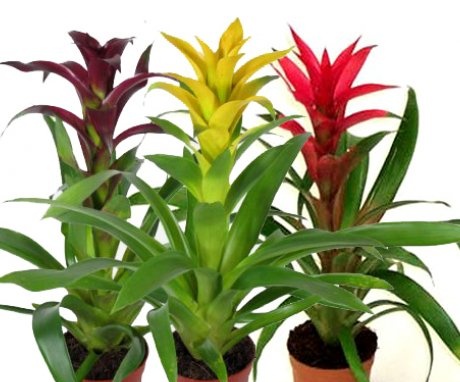
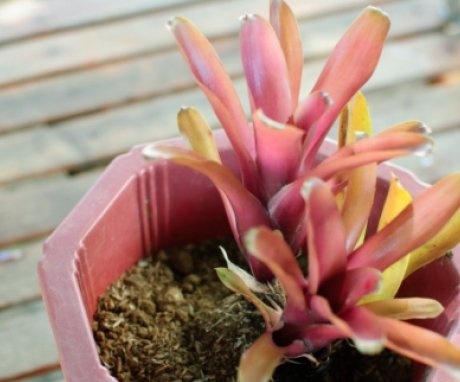
I wonder what scent this flower has? Or does it not smell? Is it suitable for allergy sufferers for breeding in the house?